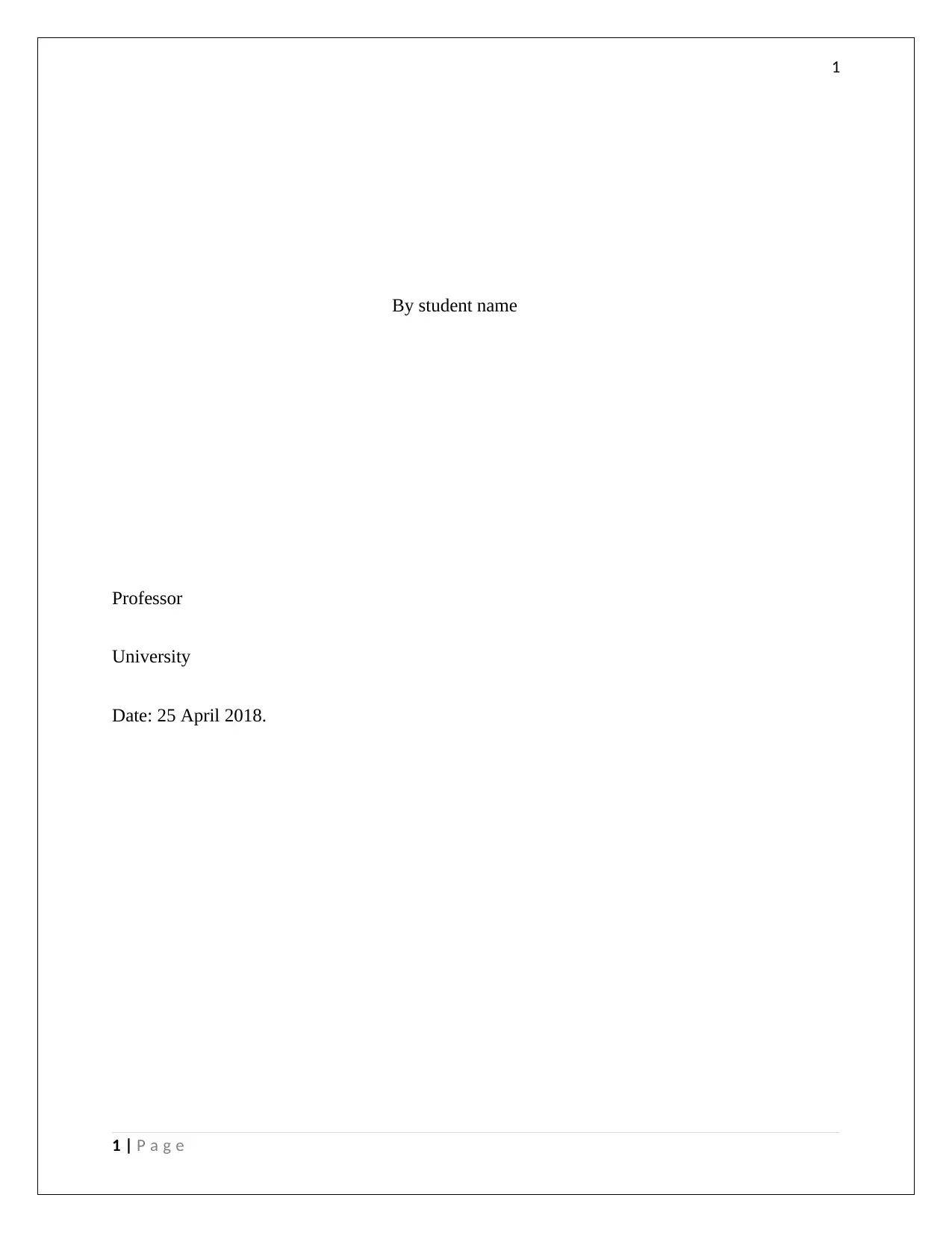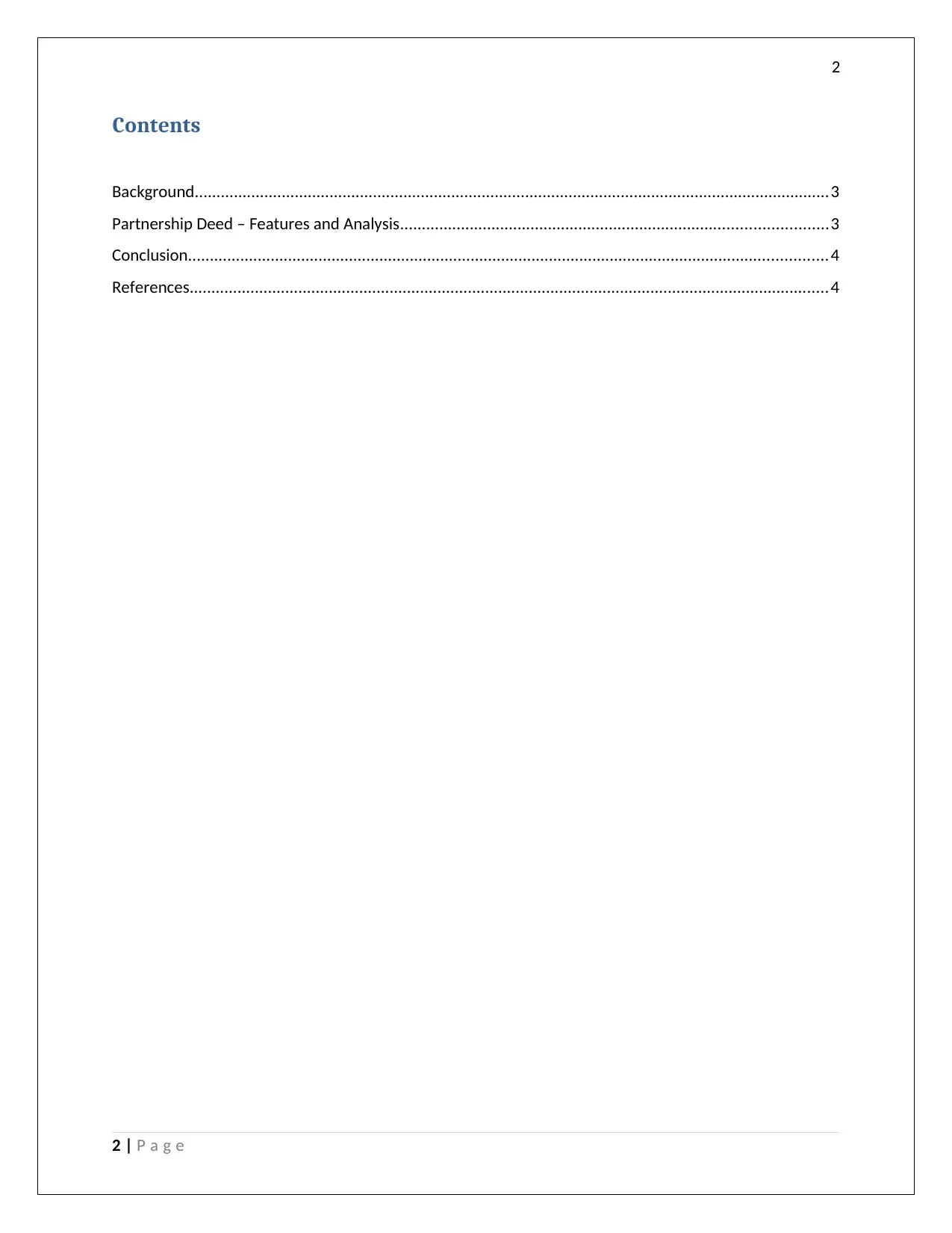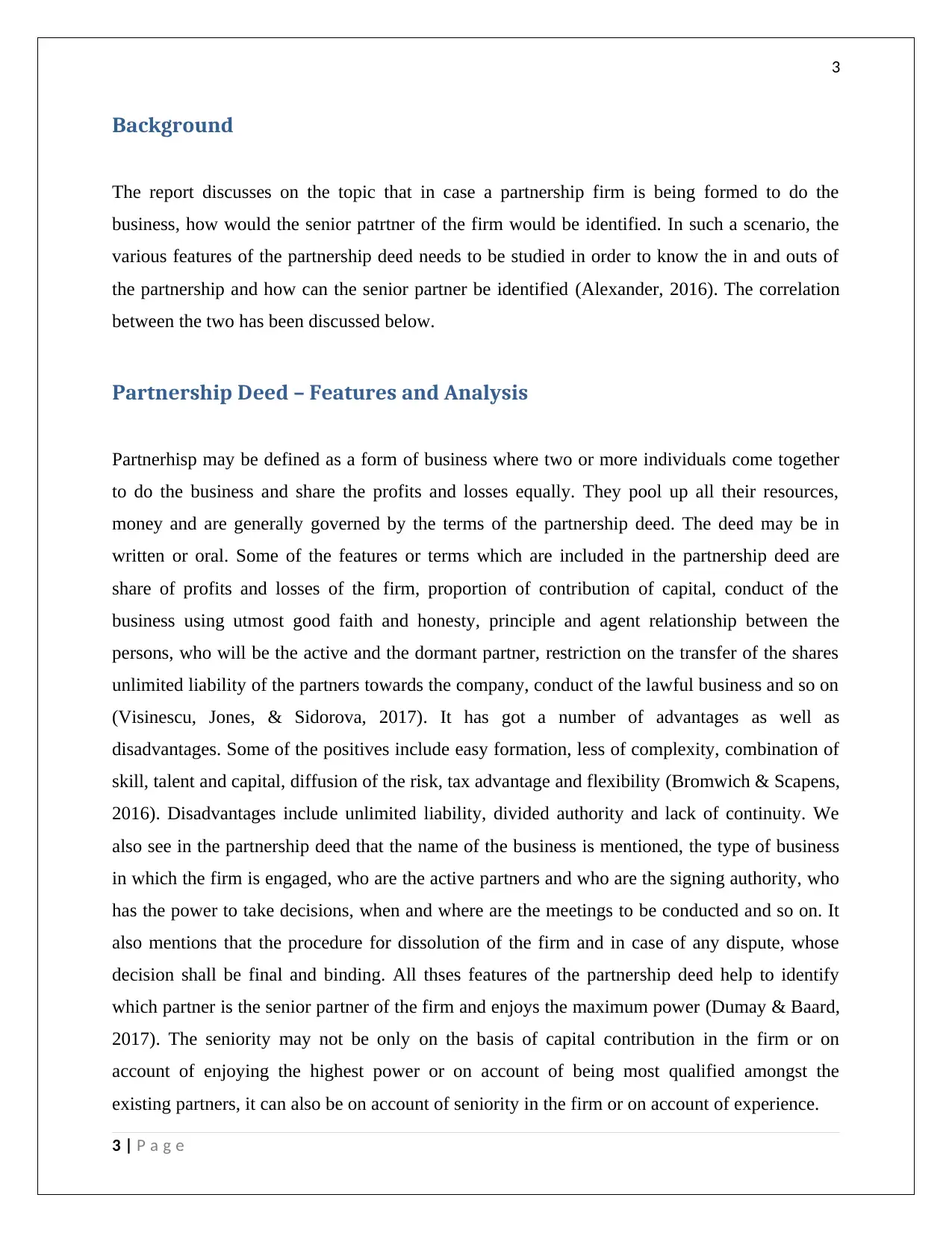Financial Accounting Report: Identifying Senior Partner in a Firm
VerifiedAdded on 2021/06/18
|5
|757
|31
Report
AI Summary
This financial accounting report examines the formation of a partnership firm and the identification of the senior partner. It delves into the features of a partnership deed, including profit and loss sharing, capital contributions, business conduct, and partner relationships. The report highlights the advantages and disadvantages of partnerships, such as ease of formation, combined skills, and potential for unlimited liability. It emphasizes how the partnership deed outlines crucial aspects like the business name, type of business, decision-making authority, and procedures for dissolution, all of which aid in determining the senior partner. The report concludes that the partnership agreement is the primary reference for identifying the senior partner, and if unclear, business conduct and decision-making roles can serve as indicators.

Paraphrase This Document
Need a fresh take? Get an instant paraphrase of this document with our AI Paraphraser

1
By student name
Professor
University
Date: 25 April 2018.
1 | P a g e
By student name
Professor
University
Date: 25 April 2018.
1 | P a g e

2
Contents
Background..................................................................................................................................................3
Partnership Deed – Features and Analysis..................................................................................................3
Conclusion...................................................................................................................................................4
References...................................................................................................................................................4
2 | P a g e
Contents
Background..................................................................................................................................................3
Partnership Deed – Features and Analysis..................................................................................................3
Conclusion...................................................................................................................................................4
References...................................................................................................................................................4
2 | P a g e
⊘ This is a preview!⊘
Do you want full access?
Subscribe today to unlock all pages.

Trusted by 1+ million students worldwide

3
Background
The report discusses on the topic that in case a partnership firm is being formed to do the
business, how would the senior patrtner of the firm would be identified. In such a scenario, the
various features of the partnership deed needs to be studied in order to know the in and outs of
the partnership and how can the senior partner be identified (Alexander, 2016). The correlation
between the two has been discussed below.
Partnership Deed – Features and Analysis
Partnerhisp may be defined as a form of business where two or more individuals come together
to do the business and share the profits and losses equally. They pool up all their resources,
money and are generally governed by the terms of the partnership deed. The deed may be in
written or oral. Some of the features or terms which are included in the partnership deed are
share of profits and losses of the firm, proportion of contribution of capital, conduct of the
business using utmost good faith and honesty, principle and agent relationship between the
persons, who will be the active and the dormant partner, restriction on the transfer of the shares
unlimited liability of the partners towards the company, conduct of the lawful business and so on
(Visinescu, Jones, & Sidorova, 2017). It has got a number of advantages as well as
disadvantages. Some of the positives include easy formation, less of complexity, combination of
skill, talent and capital, diffusion of the risk, tax advantage and flexibility (Bromwich & Scapens,
2016). Disadvantages include unlimited liability, divided authority and lack of continuity. We
also see in the partnership deed that the name of the business is mentioned, the type of business
in which the firm is engaged, who are the active partners and who are the signing authority, who
has the power to take decisions, when and where are the meetings to be conducted and so on. It
also mentions that the procedure for dissolution of the firm and in case of any dispute, whose
decision shall be final and binding. All thses features of the partnership deed help to identify
which partner is the senior partner of the firm and enjoys the maximum power (Dumay & Baard,
2017). The seniority may not be only on the basis of capital contribution in the firm or on
account of enjoying the highest power or on account of being most qualified amongst the
existing partners, it can also be on account of seniority in the firm or on account of experience.
3 | P a g e
Background
The report discusses on the topic that in case a partnership firm is being formed to do the
business, how would the senior patrtner of the firm would be identified. In such a scenario, the
various features of the partnership deed needs to be studied in order to know the in and outs of
the partnership and how can the senior partner be identified (Alexander, 2016). The correlation
between the two has been discussed below.
Partnership Deed – Features and Analysis
Partnerhisp may be defined as a form of business where two or more individuals come together
to do the business and share the profits and losses equally. They pool up all their resources,
money and are generally governed by the terms of the partnership deed. The deed may be in
written or oral. Some of the features or terms which are included in the partnership deed are
share of profits and losses of the firm, proportion of contribution of capital, conduct of the
business using utmost good faith and honesty, principle and agent relationship between the
persons, who will be the active and the dormant partner, restriction on the transfer of the shares
unlimited liability of the partners towards the company, conduct of the lawful business and so on
(Visinescu, Jones, & Sidorova, 2017). It has got a number of advantages as well as
disadvantages. Some of the positives include easy formation, less of complexity, combination of
skill, talent and capital, diffusion of the risk, tax advantage and flexibility (Bromwich & Scapens,
2016). Disadvantages include unlimited liability, divided authority and lack of continuity. We
also see in the partnership deed that the name of the business is mentioned, the type of business
in which the firm is engaged, who are the active partners and who are the signing authority, who
has the power to take decisions, when and where are the meetings to be conducted and so on. It
also mentions that the procedure for dissolution of the firm and in case of any dispute, whose
decision shall be final and binding. All thses features of the partnership deed help to identify
which partner is the senior partner of the firm and enjoys the maximum power (Dumay & Baard,
2017). The seniority may not be only on the basis of capital contribution in the firm or on
account of enjoying the highest power or on account of being most qualified amongst the
existing partners, it can also be on account of seniority in the firm or on account of experience.
3 | P a g e
Paraphrase This Document
Need a fresh take? Get an instant paraphrase of this document with our AI Paraphraser

4
Conclusion
From the above discussion it can be concluded that in order to determine the senior partner of the
firm, the first and foremost thing which needs to be referred is the partnership agreement which
will clear almost all the doubts and clarifications. In case the same does not suggest the query,
then the conduct of the business and who is taking the decision and signing most of the important
documents can be a basis for deciding who is the senior most partner in the firm.
References
Alexander, F. (2016). The Changing Face of Accountability. The Journal of Higher Education, 71(4), 411-
431.
Bromwich, M., & Scapens, R. (2016). Management Accounting Research: 25 years on. Management
Accounting Research, 31, 1-9. Retrieved from https://doi.org/10.1016/j.mar.2016.03.002
Dumay, J., & Baard, V. (2017). An introduction to interventionist research in accounting. The Routledge
Companion to Qualitative Accounting Research Methods, 265. Retrieved from
https://books.google.co.in/books?
hl=en&lr=&id=PzQlDwAAQBAJ&oi=fnd&pg=PA265&dq=Dumay,+J.,+%26+Baard,+V.+(2017).
+An+introduction+to+interventionist+research+in+accounting.
+The+Routledge+Companion+to+Qualitative+Accounting+Research+Methods,
+265.&ots=ta1isTHB
Visinescu, L., Jones, M., & Sidorova, A. (2017). Improving Decision Quality: The Role of Business
Intelligence. Journal of Computer Information Systems, 57(1), 58-66.
4 | P a g e
Conclusion
From the above discussion it can be concluded that in order to determine the senior partner of the
firm, the first and foremost thing which needs to be referred is the partnership agreement which
will clear almost all the doubts and clarifications. In case the same does not suggest the query,
then the conduct of the business and who is taking the decision and signing most of the important
documents can be a basis for deciding who is the senior most partner in the firm.
References
Alexander, F. (2016). The Changing Face of Accountability. The Journal of Higher Education, 71(4), 411-
431.
Bromwich, M., & Scapens, R. (2016). Management Accounting Research: 25 years on. Management
Accounting Research, 31, 1-9. Retrieved from https://doi.org/10.1016/j.mar.2016.03.002
Dumay, J., & Baard, V. (2017). An introduction to interventionist research in accounting. The Routledge
Companion to Qualitative Accounting Research Methods, 265. Retrieved from
https://books.google.co.in/books?
hl=en&lr=&id=PzQlDwAAQBAJ&oi=fnd&pg=PA265&dq=Dumay,+J.,+%26+Baard,+V.+(2017).
+An+introduction+to+interventionist+research+in+accounting.
+The+Routledge+Companion+to+Qualitative+Accounting+Research+Methods,
+265.&ots=ta1isTHB
Visinescu, L., Jones, M., & Sidorova, A. (2017). Improving Decision Quality: The Role of Business
Intelligence. Journal of Computer Information Systems, 57(1), 58-66.
4 | P a g e
1 out of 5
Related Documents
Your All-in-One AI-Powered Toolkit for Academic Success.
+13062052269
info@desklib.com
Available 24*7 on WhatsApp / Email
![[object Object]](/_next/static/media/star-bottom.7253800d.svg)
Unlock your academic potential
Copyright © 2020–2025 A2Z Services. All Rights Reserved. Developed and managed by ZUCOL.





